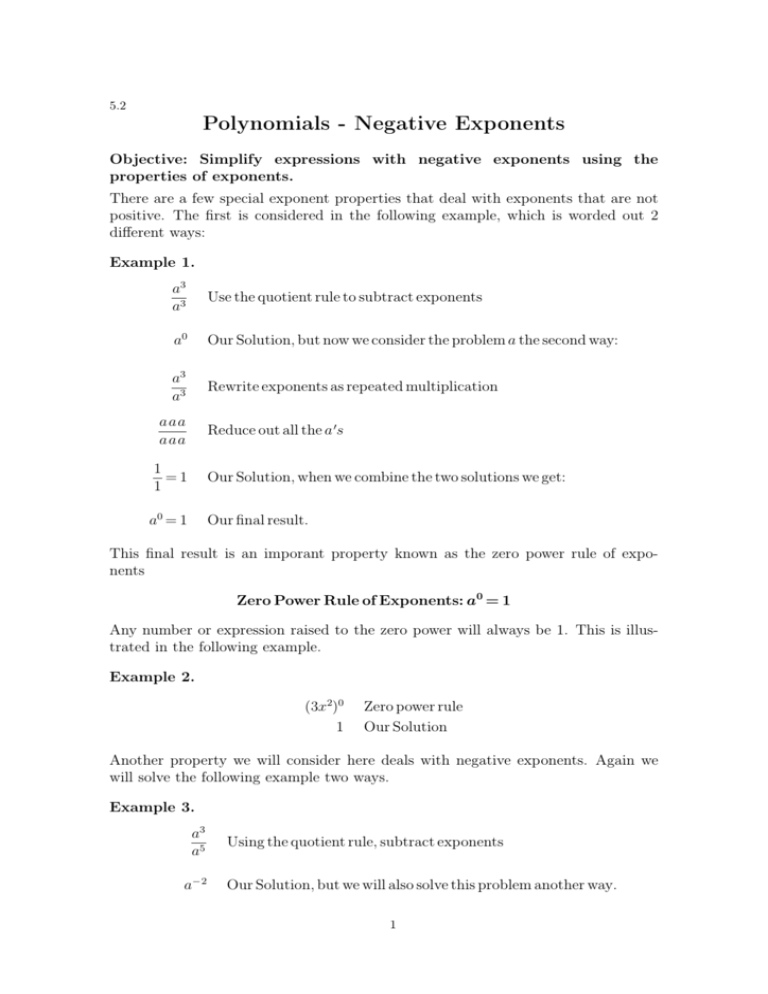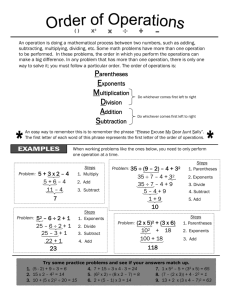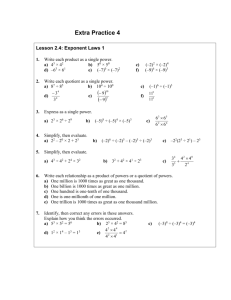Polynomials - Negative Exponents
advertisement

5.2 Polynomials - Negative Exponents Objective: Simplify expressions with negative exponents using the properties of exponents. There are a few special exponent properties that deal with exponents that are not positive. The first is considered in the following example, which is worded out 2 different ways: Example 1. a3 a3 Use the quotient rule to subtract exponents a0 Our Solution, but now we consider the problem a the second way: a3 a3 Rewrite exponents as repeated multiplication aaa aaa Reduce out all the a ′s 1 =1 1 Our Solution, when we combine the two solutions we get: a0 = 1 Our final result. This final result is an imporant property known as the zero power rule of exponents Zero Power Rule of Exponents: a0 = 1 Any number or expression raised to the zero power will always be 1. This is illustrated in the following example. Example 2. (3x2)0 1 Zero power rule Our Solution Another property we will consider here deals with negative exponents. Again we will solve the following example two ways. Example 3. a3 a5 a−2 Using the quotient rule, subtract exponents Our Solution, but we will also solve this problem another way. 1 a3 a5 aaa aaaaa a−2 = Rewrite exponents as repeated multiplication Reduce three a ′s out of top and bottom 1 aa Simplify to exponents 1 a2 Our Solution, putting these solutions together gives: 1 a2 Our Final Solution This example illustrates an important property of exponents. Negative exponents yield the reciprocal of the base. Once we take the reciprical the exponent is now positive. Also, it is important to note a negative exponent does not mean the expression is negative, only that we need the reciprocal of the base. Following are the rules of negative exponents a−m = Rules of Negative Exponets: 1 m 1 = am a−m a −m b = bm am Negative exponents can be combined in several different ways. As a general rule if we think of our expression as a fraction, negative exponents in the numerator must be moved to the denominator, likewise, negative exponents in the denominator need to be moved to the numerator. When the base with exponent moves, the exponent is now positive. This is illustrated in the following example. Example 4. a3b−2c 2d−1 e−4 f 2 a 3cde4 2b2 f 2 Negative exponents on b, d, and e need to flip Our Solution As we simplified our fraction we took special care to move the bases that had a negative exponent, but the expression itself did not become negative because of those exponents. Also, it is important to remember that exponents only effect what they are attached to. The 2 in the denominator of the above example does not have an exponent on it, so it does not move with the d. 2 We now have the following nine properties of exponents. It is important that we are very familiar with all of them. Properties of Exponents aman = am+n (ab)m = ambm am = am−n an (am)n = amn a m b = am bm a0 = 1 a−m = 1 a−m = am a −m b 1 am = bm am World View Note: Nicolas Chuquet, the French mathematician of the 15th century wrote 121m̄ to indicate 12x−1. This was the first known use of the negative exponent. Simplifying with negative exponents is much the same as simplifying with positive exponents. It is the advice of the author to keep the negative exponents until the end of the problem and then move them around to their correct location (numerator or denominator). As we do this it is important to be very careful of rules for adding, subtracting, and multiplying with negatives. This is illustrated in the following examples Example 5. 4x−5 y −3 · 3x3 y −2 6x−5 y 3 12x−2 y −5 6x−5 y 3 2x3 y −8 2x3 y8 Simplify numerator with product rule, adding exponents Quotient rule to subtract exponets, be careful with negatives! ( − 2) − ( − 5) = ( − 2) + 5 = 3 ( − 5) − 3 = ( − 5) + ( − 3) = − 8 Negative exponent needs to move down to denominator Our Solution Example 6. (3ab3)−2ab−3 2a−4b0 3−2a−2b−6ab−3 2a−4 In numerator, use power rule with − 2, multiplying exponents In denominator, b0 = 1 In numerator, use product rule to add exponents 3 3−2a−1b−9 2a−4 3−2a3b−9 2 Use quotient rule to subtract exponents, be careful with negatives ( − 1) − ( − 4) = ( − 1) + 4 = 3 Move 3 and b to denominator because of negative exponents a3 322b9 Evaluate 322 a3 18b9 Our Solution In the previous example it is important to point out that when we simplified 3−2 we moved the three to the denominator and the exponent became positive. We did not make the number negative! Negative exponents never make the bases negative, they simply mean we have to take the reciprocal of the base. One final example with negative exponents is given here. Example 7. 3x−2 y 5z 3 · 6x−6 y −2z −3 9(x2 y −2)−3 −3 18x−8 y 3z 0 9x−6 y 6 −3 (2x−2 y −3z 0)−3 2−3x6 y 9z 0 In numerator, use product rule, adding exponents In denominator, use power rule, multiplying exponets Use quotient rule to subtract exponents, be careful with negatives: ( − 8) − ( − 6) = ( − 8) + 6 = − 2 3 − 6 = 3 + ( − 6) = − 3 Parenthesis are done, use power rule with − 3 Move 2 with negative exponent down and z 0 = 1 x6 y 9 23 Evaluate 23 x6 y 9 8 Our Solution Beginning and Intermediate Algebra by Tyler Wallace is licensed under a Creative Commons Attribution 3.0 Unported License. (http://creativecommons.org/licenses/by/3.0/) 4 5.2 Practice - Negative Exponents Simplify. Your answer should contain only positive expontents. 1) 2x4 y −2 · (2xy 3)4 2) 2a−2b−3 · (2a0b4)4 3) (a4b−3)3 · 2a3b−2 4) 2x3 y 2 · (2x3)0 5) (2x2 y 2)4x−4 6) (m0n3 · 2m−3n−3)0 7) (x3 y 4)3 · x−4 y 4 8) 2m−1n−3 · (2m−1n−3)4 9) 2x−3 y 2 3x −3 y 3 · 3x0 10) 3y 3 3yx3 · 2x4 y −3 3x3 y 2 11) 4xy −3 · x−4 y 0 4y −1 12) 13) u2v −1 2u0v 4 · 2uv 14) 2xy 2 · 4x3 y −4 4x−4 y −4 · 4x 16) 2x −2 y 2 4yx2 18) (a4)4 2b 15) 17) u2 4u0v 3 · 3v 2 2y (x0 y 2)4 19) ( 2a2b3 4 ) a−1 4y −2 · 3x−2 y −4 20) ( 2y −4 −2 ) x2 2y 2 21) 2nm4 (2m2n2)4 22) 23) (2mn)4 m0n−2 24) 25) y 3 · x −3 y 2 (x4 y 2)3 26) 2x −2 y 0 · 2xy 4 (xy 0)−1 27) 2u −2v 3 · (2uv 4)−1 2u−4v 0 28) 2yx2 · x −2 (2x0 y 4)−1 30) u −3v −4 2v(2u −3v 4)0 29) ( 2x0 · y 4 3 ) y4 (x4 y 0)−4 2x −3 (x4 y −3) −1 31) y(2x4 y 2)2 2x4 y 0 32) b−1 (2a4b0)0 · 2a −3b2 33) 2yzx2 2x4 y 4z −2 · (zy 2)4 34) 2b4c−2 · (2b3c2)−4 a −2b4 35) 2kh0 · 2h −3k0 (2kj 3)2 36) ( 37) (cb3)2 · 2a −3b2 (a3b−2c3)3 38) 2q 4 · m2 p2 q 4 (2m−4 p2)3 39) (yx −4z 2)−1 z 3 · x2 y 3z −1 40) 2mpn −3 (m0n −4 p2)3 · 2n2 p0 (2x−3 y 0z −1)3 · x −3 y 2 −2 ) 2x3 Beginning and Intermediate Algebra by Tyler Wallace is licensed under a Creative Commons Attribution 3.0 Unported License. (http://creativecommons.org/licenses/by/3.0/) 5 5.2 Answers to Negative Exponents 1) 32x8 y 10 15) u2 12v 5 29) 8 2) 32b13 a2 16) y 2x4 30) 3) 2a15 b11 17) 2 y7 31) 2y 5x4 18) a16 2b 32) a3 2b3 19) 16a12b12 33) 1 x2 y 11z 20) y 8x4 4 34) 21) 1 8m4n7 a2 8c10b12 35) 1 h3k j 6 36) x30 z 6 16y 4 4) 2x3 y 2 5) 16x4 y 8 6) 1 16 5 7) y x 8) 32 m5n15 9) 2 9y 10) y5 2x7 11) 1 y 2 x3 22) 2x16 y 2 23) 16n6m4 1 2u3v 5 24) 2x y3 37) 2b14 a12 c7 25) 1 x15 y 38) m14 q 8 4p4 39) x2 y 4z 4 40) mn7 p5 12) y 8 x5 4 13) u 4v 6 27) 14) x7 y 2 2 28) 4y 5 26) 4y 4 u 2v Beginning and Intermediate Algebra by Tyler Wallace is licensed under a Creative Commons Attribution 3.0 Unported License. (http://creativecommons.org/licenses/by/3.0/) 6






